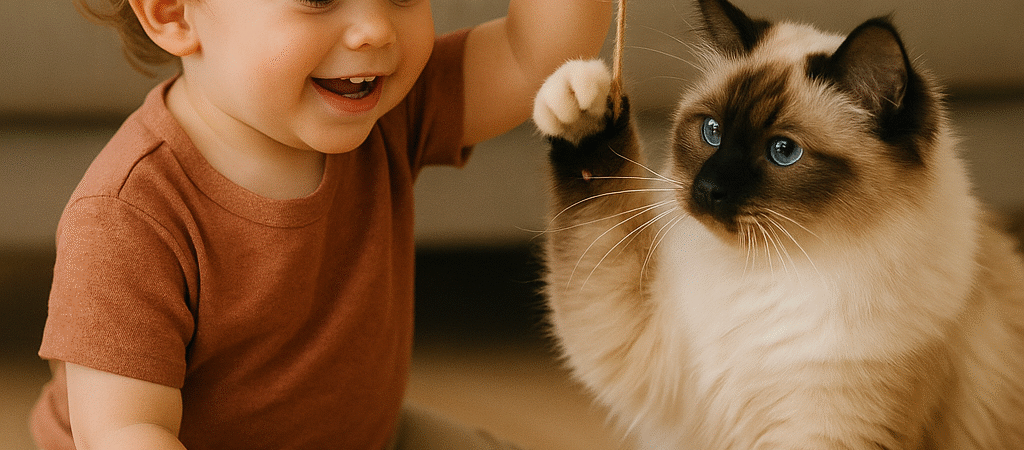Meta Description: Discover the 10 most family-friendly cat breeds perfect for homes with children. Learn about temperament, care needs, and what makes these cats ideal family pets.
Choosing the right cat breed for your family is one of the most important decisions you’ll make as a pet parent. While all cats have unique personalities, certain breeds have been selectively developed for their gentle, sociable, and family-friendly temperaments that make them exceptional companions for households with children, multiple pets, and busy lifestyles.
The perfect family cat should be patient with children, adaptable to household chaos, social with strangers, and comfortable in active environments. These breeds have earned their reputation as outstanding family pets through generations of careful breeding that emphasized friendly dispositions, stable temperaments, and genuine affection for human companionship.
Whether you’re a first-time cat owner or looking to add another feline family member, understanding the characteristics of these exceptionally friendly breeds will help you make the best choice for your unique family situation. Let’s explore the top 10 friendliest cat breeds that consistently excel as loving, patient, and devoted family companions.
1. Ragdoll: The Ultimate Gentle Giant
Temperament: Known for their docile, relaxed nature and tendency to go limp when picked up (hence the name “Ragdoll”), these cats are renowned for their exceptional patience with children and calm demeanor.
Family-Friendly Features: Ragdolls are famous for their tolerance of handling, making them ideal for families with young children who want to carry and cuddle their cat. They’re large, sturdy cats that can handle gentle roughhousing and rarely use their claws defensively. Their laid-back personality means they adapt well to busy households and don’t become easily stressed by noise or activity.
Physical Characteristics: These are substantial cats, with males weighing 15-20 pounds and females 10-15 pounds. They have semi-long, silky coats that come in colorpoint, mitted, and bicolor patterns. Their striking blue eyes and beautiful coat patterns make them as gorgeous as they are gentle.
Care Considerations: Ragdolls require regular brushing 2-3 times per week to prevent matting, but their coat is less prone to tangling than other long-haired breeds. They’re indoor cats by nature and lack the defensive instincts that would keep them safe outdoors.
Best For: Families with young children, first-time cat owners, and households wanting a calm, cuddly companion who enjoys being handled.
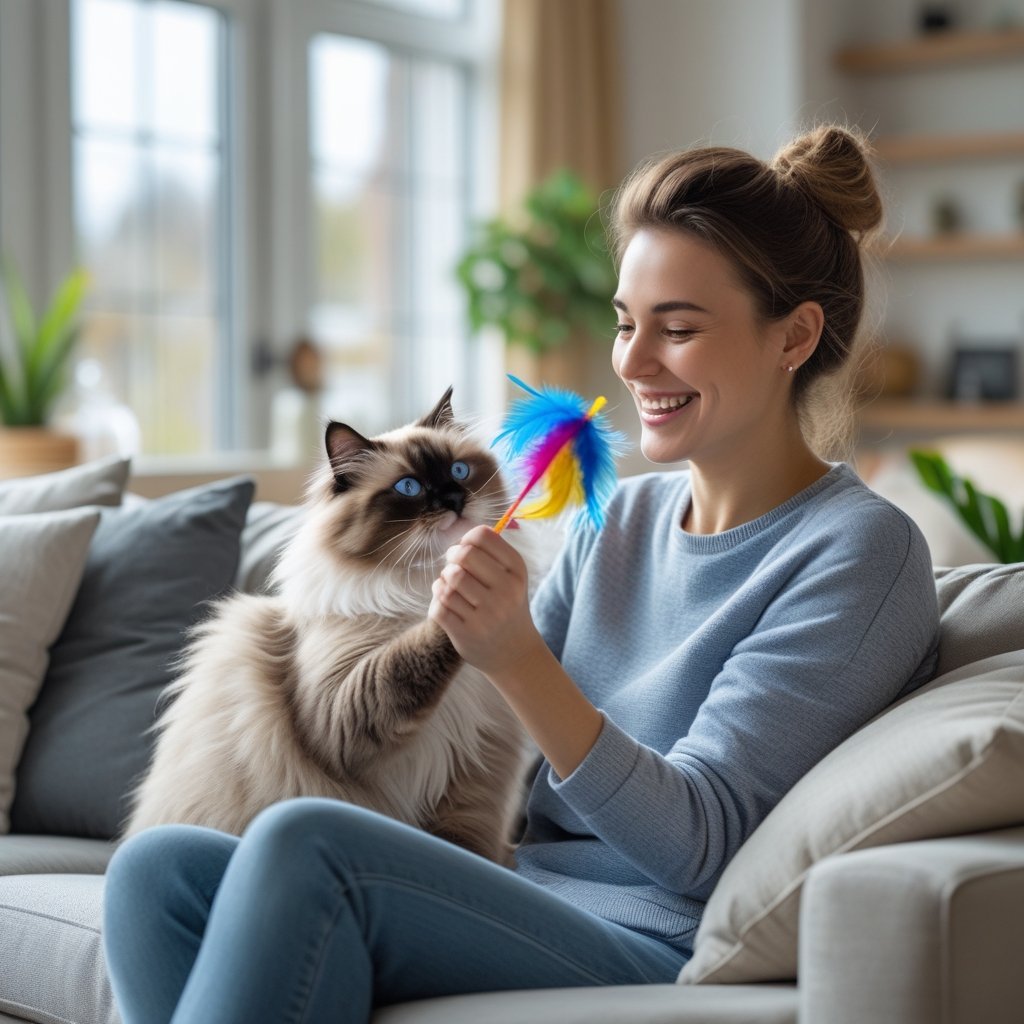
2. Maine Coon: The Friendly Forest Cat
Temperament: Often called “dog-like” in their loyalty and social behavior, Maine Coons are gentle giants with sweet, outgoing personalities and natural comfort around people of all ages.
Family-Friendly Features: Maine Coons are incredibly patient with children and often seek out family activities rather than hiding. They’re known for following family members around the house and participating in daily routines. Their size and sturdy build make them resilient to enthusiastic petting, and they typically respond to rough handling by simply walking away rather than scratching or biting.
Physical Characteristics: As America’s largest domestic cat breed, Maine Coons can weigh 13-25 pounds, with distinctive ear tufts, a bushy tail, and a weatherproof double coat. They come in numerous colors and patterns, with tabby variations being most common.
Care Considerations: Their thick coat requires regular brushing, especially during shedding seasons. Maine Coons are generally healthy but should be screened for hypertrophic cardiomyopathy and hip dysplasia. They mature slowly, not reaching full size until 3-4 years old.
Best For: Active families who want an interactive cat, households with other pets, and families who appreciate a majestic, substantial feline presence.
3. Persian: The Aristocratic Lap Cat
Temperament: Persians are known for their sweet, gentle, and quiet nature. They prefer calm environments and form deep bonds with their family members, making them excellent companions for peaceful households.
Family-Friendly Features: While Persians prefer gentler handling than some breeds, they’re exceptionally patient and rarely aggressive. They’re perfect for families who want a beautiful, affectionate cat that enjoys being admired and petted but doesn’t demand constant activity. Their calm nature makes them excellent therapy cats and wonderful companions for elderly family members.
Physical Characteristics: Persians are medium-sized cats with distinctive flat faces, large round eyes, and luxurious long coats that come in a wide variety of colors and patterns. Their compact, cobby build and flowing coat give them an unmistakably regal appearance.
Care Considerations: Persians require daily brushing to prevent matting and may need professional grooming. Their flat faces can cause breathing issues and tear staining that requires regular cleaning. They’re strictly indoor cats due to their grooming needs and gentle nature.
Best For: Families who enjoy grooming activities, households with older or calmer children, and those who want a beautiful, serene feline companion.
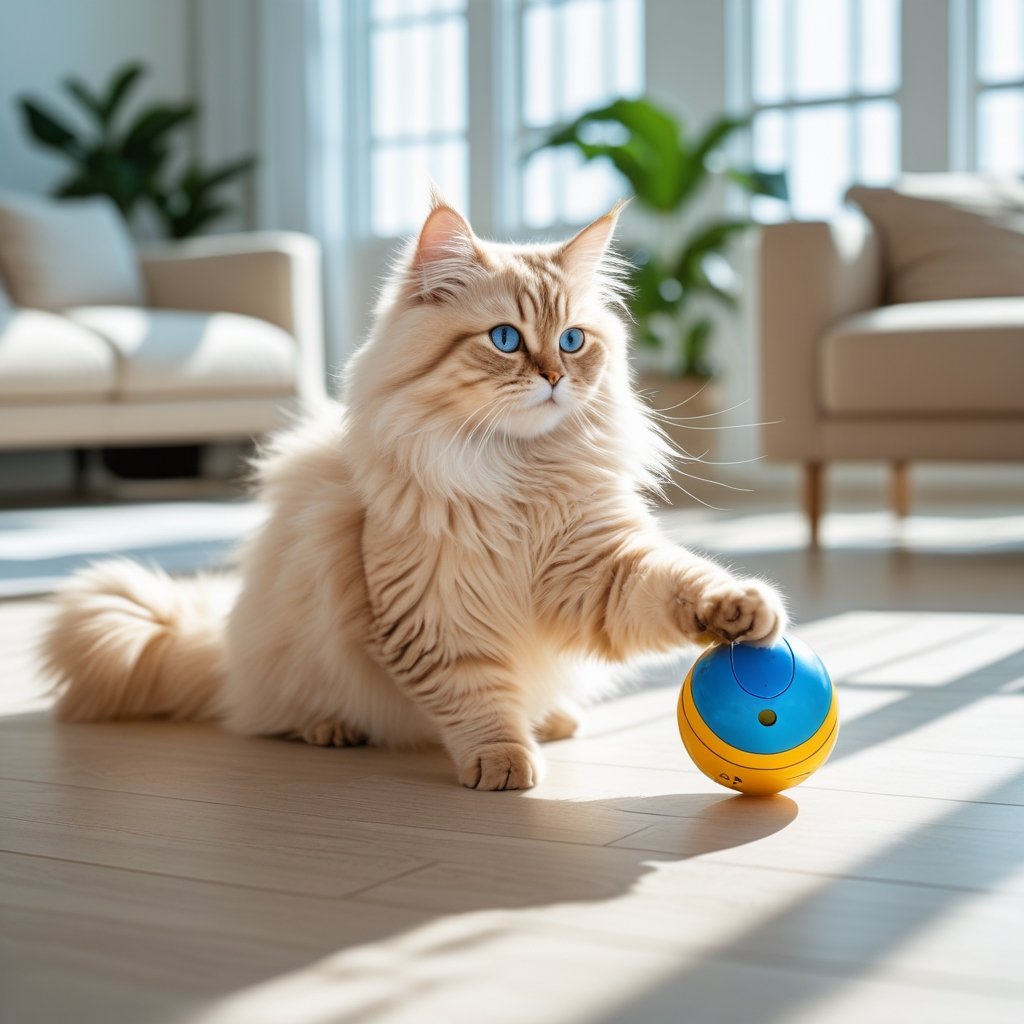
4. Siamese: The Talkative Family Member
Temperament: Siamese cats are highly social, intelligent, and vocal. They form intense bonds with their families and are known for their dog-like loyalty and desire to be involved in every family activity.
Family-Friendly Features: Siamese cats thrive in active family environments and often choose a favorite family member while remaining friendly with everyone. They’re excellent with children who appreciate their interactive nature and enjoy “conversations” with their vocal feline friend. Their intelligence makes them trainable and entertaining family companions.
Physical Characteristics: Siamese cats are medium-sized with distinctive colorpoint patterns (darker colors on ears, face, legs, and tail), striking blue eyes, and sleek, athletic builds. They’re elegant cats with triangular faces and large ears.
Care Considerations: Siamese cats have minimal grooming needs due to their short coat, but they require significant mental stimulation and social interaction. They can become destructive or overly vocal if left alone for long periods.
Best For: Active families who enjoy interactive pets, households where someone is usually home, and families who appreciate vocal, communicative cats.
5. Burmese: The Social Butterfly
Temperament: Burmese cats are outgoing, affectionate, and people-oriented. They’re known for their playful nature that extends well into adulthood and their genuine enjoyment of human company.
Family-Friendly Features: Burmese cats are excellent with children and often initiate play sessions. They’re confident around strangers and adapt well to new situations, making them perfect for social families who have frequent visitors. Their sturdy build and playful nature make them ideal companions for active children.
Physical Characteristics: Burmese are medium-sized, muscular cats that are surprisingly heavy for their size. They have short, glossy coats in rich solid colors like sable, champagne, blue, and platinum, with expressive gold or yellow eyes.
Care Considerations: Their short coat requires minimal grooming, but they need plenty of interaction and mental stimulation. Burmese cats are generally healthy but should be monitored for certain genetic conditions like hypokalemic myopathy.
Best For: Social families with active lifestyles, households with multiple pets, and families who want an engaging, interactive feline companion.
6. Birman: The Sacred Temple Cat
Temperament: Birmans are gentle, quiet, and devoted companions with a perfect balance of affection and independence. They’re known for their sweet nature and ability to sense their family’s moods.
Family-Friendly Features: Birmans are incredibly patient with children and have a natural gentleness that makes them safe around even very young family members. They’re social without being demanding and adapt well to family routines while maintaining their calm, serene demeanor.
Physical Characteristics: Birmans are medium to large cats with semi-long, silky coats, distinctive white “gloves” on their paws, and striking blue eyes. They have colorpoint patterns similar to Siamese but with a softer, more rounded appearance.
Care Considerations: Their coat requires regular brushing but is less prone to matting than other long-haired breeds. Birmans are generally healthy cats with few breed-specific health concerns.
Best For: Families wanting a calm, beautiful cat, households with mixed age groups, and those who appreciate a gentle, intuitive feline companion.
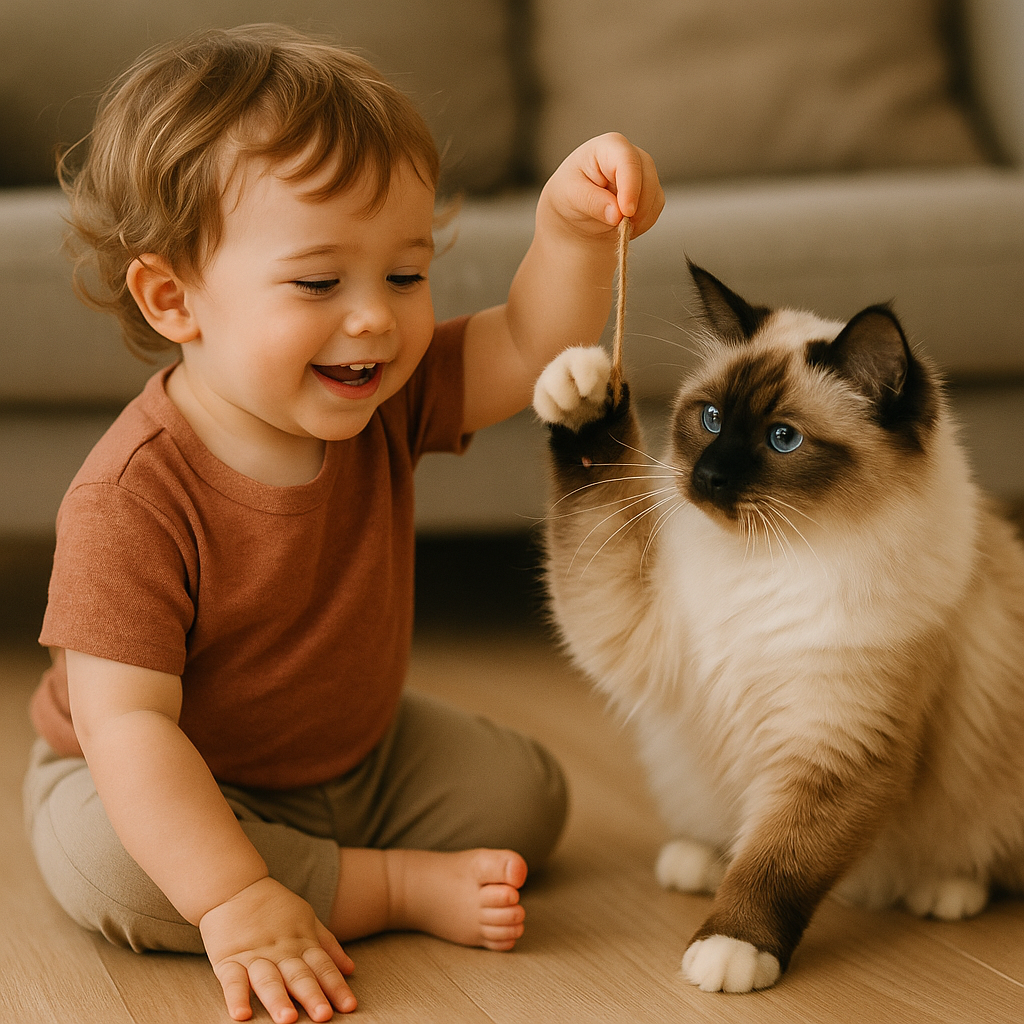
7. Abyssinian: The Active Adventure Cat
Temperament: Abyssinians are curious, intelligent, and highly active cats with friendly, outgoing personalities. They love to explore, climb, and investigate everything in their environment.
Family-Friendly Features: Abyssinians are excellent with older children who can match their energy level and appreciate their playful, adventurous nature. They’re social cats who enjoy family activities and are often found perched high up, observing household activities with interest.
Physical Characteristics: Abyssinians are medium-sized cats with distinctive “ticked” coats that give them a wild appearance. They have large ears, almond-shaped eyes, and athletic builds that reflect their active nature.
Care Considerations: Their short coat requires minimal grooming, but they need plenty of vertical space, interactive toys, and mental stimulation to prevent boredom. Abyssinians can be prone to certain genetic conditions like pyruvate kinase deficiency.
Best For: Active families with older children, households that enjoy interactive play, and families who can provide plenty of environmental enrichment.
8. Scottish Fold: The Sweet-Tempered Companion
Temperament: Scottish Folds are known for their calm, easy-going nature and adaptability. They’re affectionate without being clingy and have a reputation for being excellent with children and other pets.
Family-Friendly Features: Scottish Folds are incredibly patient and rarely show aggression, making them ideal for families with young children. Their unique folded ears and round faces give them an adorable, almost teddy bear-like appearance that children love. They adapt well to various living situations and family dynamics.
Physical Characteristics: Scottish Folds are medium-sized cats known for their distinctive folded ears (though not all have folded ears). They have round faces, large eyes, and come in both short and long-haired varieties in numerous colors and patterns.
Care Considerations: The fold gene can cause cartilage problems, so responsible breeding and health screening are important. They may require special attention to ear cleaning and joint health monitoring.
Best For: Families with young children, first-time cat owners, and households wanting a adaptable, gentle companion.
9. American Shorthair: The All-American Family Cat
Temperament: American Shorthairs are well-balanced cats with moderate energy levels, friendly dispositions, and excellent adaptability to family life. They’re neither overly demanding nor aloof.
Family-Friendly Features: These cats are naturally good with children and have the perfect temperament for busy family life. They’re playful enough to enjoy interactive games but calm enough to be good lap cats. Their sturdy build and even temperament make them excellent choices for families with varying experience levels.
Physical Characteristics: American Shorthairs are medium to large, well-muscled cats with broad chests and strong builds. They come in over 80 color and pattern combinations, with silver tabby being the most recognized.
Care Considerations: Their short coat requires minimal grooming, and they’re generally healthy cats with few breed-specific issues. They can be prone to obesity, so diet management is important.
Best For: First-time cat owners, families with varying schedules, and households wanting a low-maintenance, reliable feline companion.
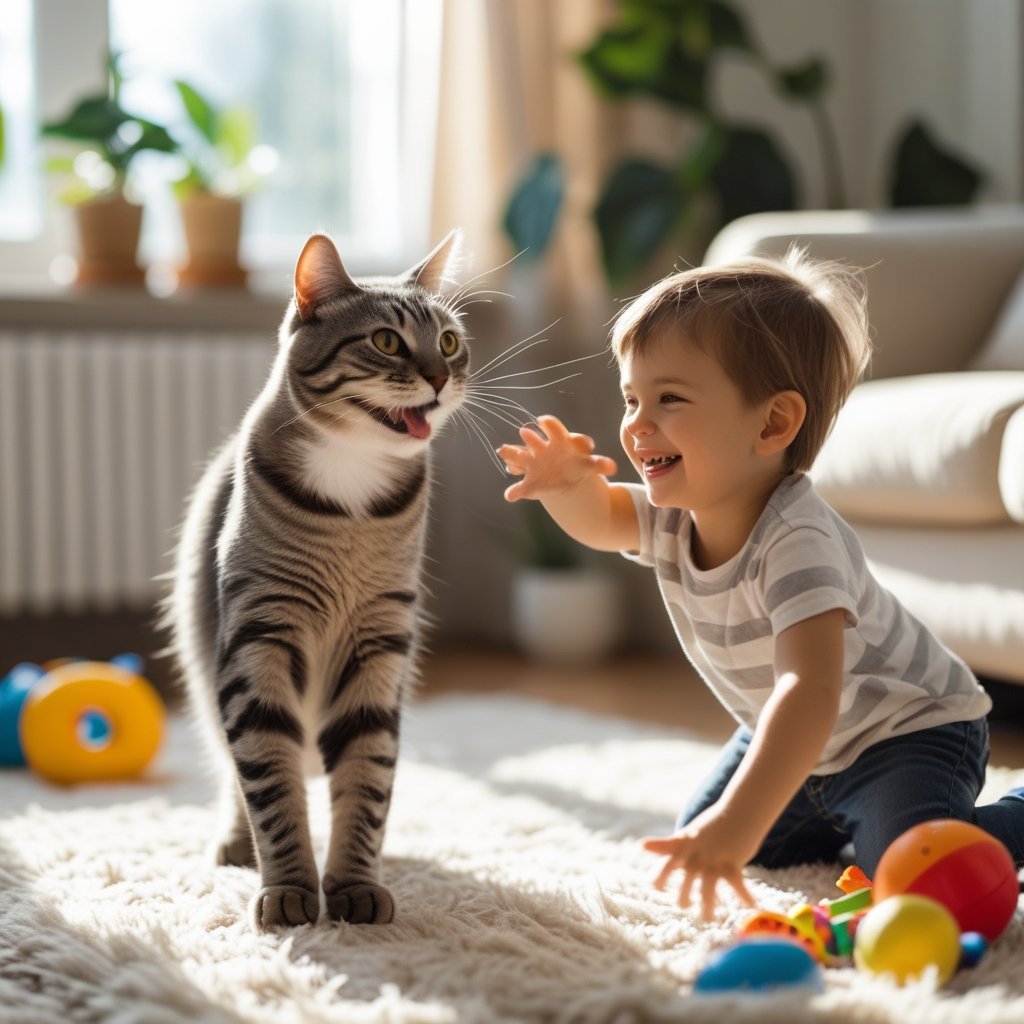
10. Exotic Shorthair: The Persian’s Easy-Care Cousin
Temperament: Exotic Shorthairs have the sweet, gentle personality of Persians but with a more playful edge. They’re affectionate, calm, and excellent with families while being more active than their long-haired cousins.
Family-Friendly Features: Exotic Shorthairs combine the best traits for family life: the gentle, patient nature of Persians with easier care requirements and a bit more playfulness. They’re excellent with children and adapt well to household activity while maintaining their sweet, loving nature.
Physical Characteristics: Exotic Shorthairs look like short-haired Persians with the same flat faces, round eyes, and cobby builds but with plush, dense coats that are much easier to maintain.
Care Considerations: Their short coat requires minimal grooming compared to Persians, but they may still have breathing issues related to their flat faces. Regular face cleaning and monitoring for respiratory problems are important.
Best For: Families who love the Persian look but want easier maintenance, households with children of all ages, and those wanting a calm but not sedentary cat.
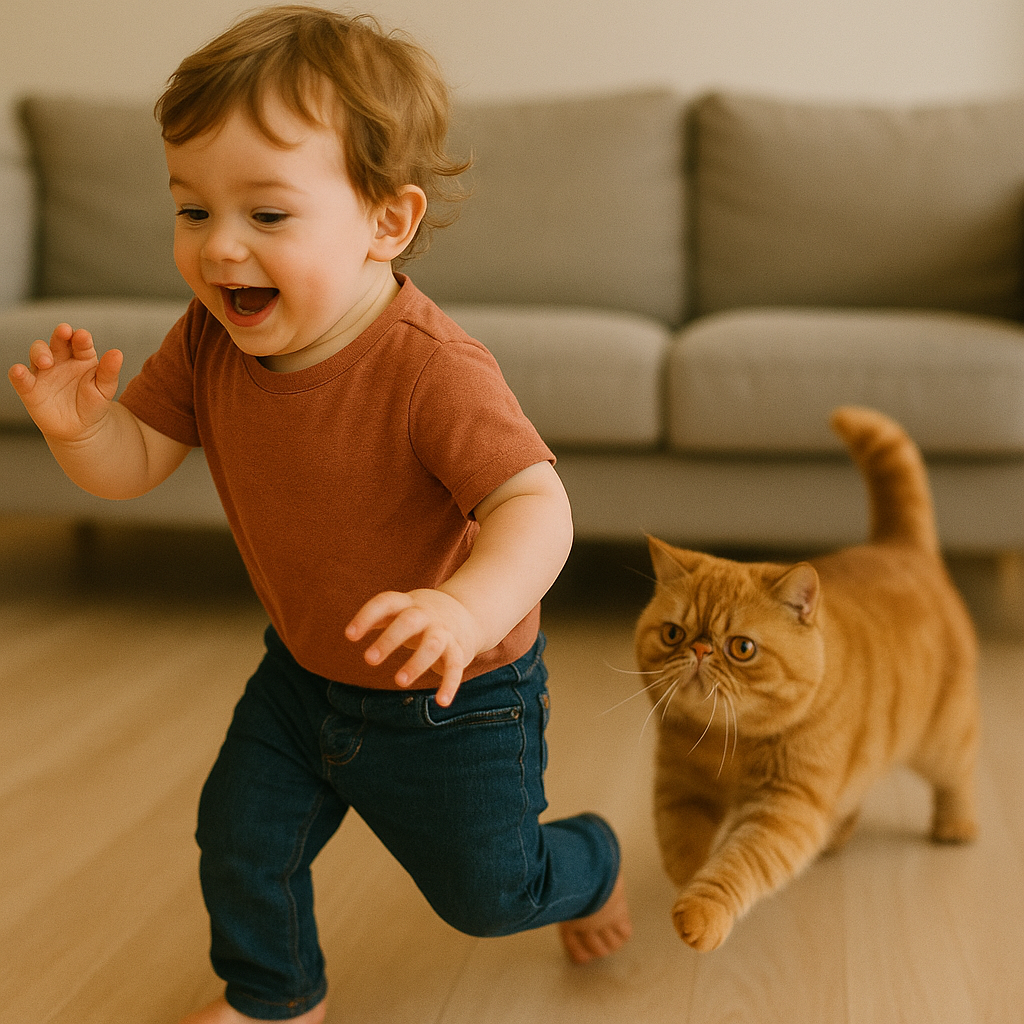
Choosing the Right Breed for Your Family
When selecting a family-friendly cat breed, consider several important factors beyond just temperament.
Family Lifestyle Considerations
Activity Level: Match the cat’s energy level to your family’s lifestyle. Active breeds like Abyssinians need families who can provide plenty of stimulation, while calmer breeds like Persians suit quieter households.
Time Commitment: Consider grooming needs, social requirements, and health monitoring that different breeds require.
Children’s Ages: Very young children might do better with extremely patient breeds like Ragdolls, while older children might enjoy more interactive breeds like Siamese.
Living Situation Factors
Space Requirements: Some breeds need more vertical territory and environmental enrichment than others.
Other Pets: Consider how well the breed typically gets along with dogs and other cats.
Noise Tolerance: Some breeds are more adaptable to household noise and chaos than others.
Long-Term Commitment
Lifespan: Most cats live 12-18 years, so consider your family’s long-term stability.
Health Costs: Some breeds have more potential health issues that could require veterinary attention.
Grooming Expenses: Long-haired breeds may need professional grooming regularly.
Preparing Your Home for a Family Cat
Regardless of breed, preparing your home properly ensures success with your new family member.
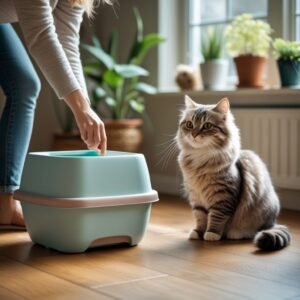
Safety Considerations
Child-Proofing: Ensure your cat will be safe around children and vice versa by establishing safe spaces and teaching proper handling.
Pet-Proofing: Remove toxic plants, secure dangerous items, and create safe spaces for your cat to retreat when overwhelmed.
Essential Supplies
Multiple Resources: Provide several litter boxes, water sources, and feeding areas to prevent stress.
Enrichment Items: Scratching posts, climbing structures, and interactive toys keep cats mentally stimulated and physically healthy.
Comfort Items: Cozy beds, hiding spots, and perches help cats feel secure in their new environment.
Frequently Asked Questions About Family-Friendly Cat Breeds
Q: Are mixed breed cats less friendly than purebreds?
A: Not at all! Mixed breed cats can be just as friendly and family-oriented as purebreds. Individual personality matters more than breed, though purebreds may have more predictable temperaments.
Q: How do I introduce a new cat to children safely?
A: Start with supervised interactions, teach children proper handling techniques, and ensure the cat has escape routes and safe spaces. Let the cat set the pace for interaction.
Q: Which breeds are best for families with babies?
A: Patient, calm breeds like Ragdolls, Birmans, and Persians tend to adapt best to babies. However, proper introduction and supervision are crucial regardless of breed.
Q: Do friendly cat breeds require less training?
A: Friendly cats may be more receptive to training, but all cats benefit from basic training like scratching post use, litter box habits, and handling tolerance.
Q: How important is early socialization for family cats?
A: Early socialization is crucial for all cats but especially important for family pets who will encounter various people, sounds, and situations throughout their lives.
Conclusion: Finding Your Perfect Feline Family Member
The friendliest cat breeds for families share common traits of patience, adaptability, and genuine affection for human companionship. However, remember that individual personality, proper socialization, and your family’s specific needs are just as important as breed characteristics when choosing your perfect feline companion.
Whether you choose a gentle giant Ragdoll, a talkative Siamese, or a calm Persian, the key to success lies in matching the cat’s needs with your family’s lifestyle and commitment level. All of these wonderful breeds have the potential to become beloved family members who enrich your lives with their unique personalities, unconditional love, and endless entertainment.
Take time to research breeders carefully, meet potential cats in person when possible, and prepare your home properly for your new arrival. With the right choice and proper preparation, your family-friendly cat will become an irreplaceable part of your household, creating memories and bonds that last a lifetime.
The journey of finding the perfect family cat is exciting and rewarding. These top 10 friendly breeds offer excellent starting points for families ready to experience the joy, love, and companionship that only a well-matched feline friend can provide.
Which family-friendly breed appeals most to your household? Share your experiences with family cats in the comments below!
Ready to welcome a family-friendly cat into your home? Check out our recommendations for cat supplies, family-safe toys, and grooming tools that make life easier for both cats and the families who love them.
Related Articles You Might Enjoy:
- “The Maine Coon: Giant Gentle Cats Everyone Loves”
- “15 Funniest Cat Behaviors Explained”
- “Understanding Cat Body Language: What Your Cat Is Really Telling You”
- “Why Cats Love Boxes (and How to Use This to Enrich Their Lives)”
Keywords: friendliest cat breeds, family-friendly cats, best cats for families, cat breeds for children, gentle cat breeds, family pets, cat temperament, kid-friendly cats, family cat selection, pet-friendly households

